#research scholarships 2018
Explore tagged Tumblr posts
Text
Writing a comprehensive history of Polish citizens during the Holocaust is a hefty task. A Polish law that criminalizes any mention of Polish responsibility for or complicity in Nazi crimes makes it even harder.
That makes the groundbreaking research conducted by acclaimed Holocaust historian Jan Grabowski for his new book, “On Duty: The Polish Blue & Criminal Police in the Holocaust” all the more remarkable.
Relying on meticulous documentation, the book argues that Polish institutions were more than willing to assist the Nazis in their extermination campaign, and often led the way through their own initiatives. Grabowski, a professor at the University of Ottawa, spent more than 10 years conducting the research, including years in Poland going through Polish archives, private diaries and records from more than 100 small towns where Jews lived in high concentrations.
“I read horrifying things in the diaries of Polish policemen describing how many Jews they killed each day,” said Grabowski, 61. “There were anecdotes about a cop asking for a glass of vodka before shooting a Jew, or using hot water to clean the blood off their hands. They killed friends and schoolmates without remorse, even in places where no Germans ever came to check up on them.”
Much of the evidence Grabowski uncovered had never been seen before.
“It’s not easy to write a book like this when you have opposition from massive Polish organizations with teams of PhDs whose job is to go after people like myself,” said Grabowski, who began his research for the book before Poland passed the controversial 2018 Act on the Institute of National Remembrance. “But thorough and independent historical research is necessary to make sure that a nation can’t rewrite its history into a happy story of righteous Poles saving Jews.”
In particular, the book focuses on the actions of Poland’s Blue Police, officially known as the Polish Police of the Generalgouvernement, established shortly after the German occupation of Poland in 1939 and consisting mainly of prewar Polish police officers.
“We are talking about a police force of 20,000 people that previously was in charge of enforcing mundane civilian laws like making sure that horses walking on the street had horseshoes,” Grabowski said. “What fascinates me is how quickly these normal ordinary cops were transformed into ruthless killers.”
Grabowski’s 496-page book is now available on Yad Vashem’s website.
Grabowski has written numerous books and articles focusing on the Holocaust in Poland. His book “Hunt for the Jews: Betrayal and Murder in German-Occupied Poland” won the Yad Vashem International Book Prize in 2013.
On the eve of World War II, Poland’s 3.3 million Jews formed a vibrant and diverse society, noted Havi Dreifuss, director of the Center for Research on the Holocaust in Poland at Yad Vashem and professor of Jewish history at Tel Aviv University.
“Many were engaged in Jewish and Polish causes or active in political movements such as the Bund, Zionist, and Orthodox groups. While most lived in cities, these were often small, alongside villages that reflected the richness of Polish Jewish life.”
This last point is a critical issue for Holocaust scholarship, Dreifuss said.
“Research often focuses on large ghettos like Warsaw and Lodz, each housing hundreds of thousands of Jews. But over 340 ghettos existed in the Generalgouvernement, 83% of them with fewer than 5,000 Jews,” she said. “These smaller ghettos, representing the majority of Polish Jewish communities, remain understudied, despite their significant role in understanding Polish Jewry during the Holocaust.”
Chronologically, Polish persecution of the Jews progressed in three stages, according to Grabowski.
After Germany invaded Poland in 1939, the Third Reich entrusted Polish police forces to introduce and enforce new restrictions on the Jews.
“The first phase was the beginning of the inhuman ghettoization of the Jews,” Grabowski said. “The Germans created laws designed to break down the Jews, limiting where they could go and what they could do or own. Yet until now, virtually no historians have examined how the large Polish police force suddenly became so deeply involved with Jewish affairs, effectively condemning them to starvation.”
By 1941, Polish forces began working on the second phase, liquidating hundreds of ghettos. As trainloads of Jews were sent to concentration camps like Auschwitz-Birkenau and Treblinka in 1942 and 1943, Polish police participated in the Nazi evacuations of these ghettos, rounding Jews up, killing anyone who resisted and sometimes even conducting the evacuations themselves.
“It is important to understand that it wasn’t the Germans coercing the Poles to shoot; it was the Polish execution squads making these decisions themselves,” Grabowski said. “In November 1941, Polish police were shooting Jews on a regular basis, much earlier than in Nazi-occupied countries in Western Europe.”
Perhaps the Poles were just acting to avoid facing punishment from the Nazis?
“The interesting thing is that there is no record of any penalty given to someone who refused to kill a Jew, except maybe some sneers by your colleagues,” Grabowski said. “If you didn’t want to do it, there was always someone else who would be happy to.”
After the ghettos were liquidated, Polish forces continued their killing sprees through the third phase, searching throughout the country for Jews who may have escaped, according to Grabowski.
“At this point, they are murdering with gusto, without any German involvement,” according to Grabowski. “They are working with locals, with their neighbors, and they don’t even inform the Germans about what they are doing.”
As the Holocaust progressed, Polish police acted on their own to kill Jews without coordinating with Germany, Grabowski said.
“They knew that if they reported their activities to the Nazis they would have been forced to share the money and property they stole,” he said. “They might also incriminate their neighbors who were actively sheltering Jews. And they didn’t want that.”
Poland’s Foreign Ministry declined to respond to the claims in Grabowski’s books, saying, “The Ministry of Foreign Affairs does not comment on the scientific activities of individual people, considering scientific sphere and activity exempt from political assessment.”
While writing “On Duty,” Grabowski faced a powerful barrage of opposition from the Polish government and was slapped with a number of lawsuits, two of which are still pending.
“It has not been good for my psychological well-being,” Grabowski said. “When you study for a PhD, no one trains you in how to handle attacks from the state for slandering the good name of the nation.”
But exposing the truth is exactly why Grabowski believes his work is important.
“The Holocaust has become a universal benchmark of evil, but even after decades of Holocaust education, you have governments bending history out of shape to conform with their own needs,” he said. “This is a very dangerous precedent, and we have a responsibility to prevent it to preserve our future.”
62 notes
·
View notes
Text
It's probably time to admit Nico's monaco based youtuber days are over 🥲
in 2023 he only posted 1 video, 8 months ago. In 2022, when he got his rimac his videos popped off among car enthusiasts with over a million views (he was the very first! that's where the monaco based youtuber headline came from lol) and he promised a bunch of stuff he was gonna film with it, like drag racing and 0-1s accelerations but he never did. nicotube was always a passion project, he never did ads or sponsors. in 2017/2018 he was using it to find his post f1 career footing, those videos were more car porn, driving around in fancy sportscars, vlogs of boats or even f1 race vlogs and recaps, starting his own karting team (which kimi antonelli raced in!), and finally dipping his toes into sustainability with greentech festival. he started doing one hour podcast sessions with f1 and then other notable figures, which really popped off during covid. also doing f1 simulator races of every track and talking about the best ways/corners to drive and optimise the track. even tracks he never drove, like he did the sim for Miami in 2022, but not vegas. f1 is ofc his childhood love, he talks about the sport and his career fondly but even that with his sky commentary duties he only attends like 5 races, and no more race vlogs or his driver rankings of the season.
these days, his most used social media is linkedin actually. he's big on tech, startups, and specifically sustainability. esp with Rosberg Philanthropies where he's funding scholarships to phd grads in Oxford who research in sustainability and environmentally friendly tech. so making videos of ferrari car porn doesn't really align with the brand unless it's to promote electric cars.
does that mean his YouTube channel is over? no. I wouldn't be surprised if he drops another video whenever he feels like it, but the olden days of a bunch of sleekly produced videos every other week are long gone. he's moved past it and gotten into other projects he cares about and knowing the rosbergs I wouldn't be surprised if he slowly transitions into more projects where he's not the public facing front of it anymore.
I loved nicotube. i probably wouldn't be as big of a fan if I hadn't discovered it because it allowed a glimpse into nico outside of f1 driver, outside of sky sports narrative, just nico rosberg the person who is genuine in his enthusiasm of explaining how car wings work, who is cringe and funny and endearing and embarrassing. there's some absolute gems there. I'm sad there won't be more but hey, people change and people grow. 🥹 nico especially f1 fandom at large likes to box into unchanging, fixed category, like he was f1 driver til 2016, then monaco youtuber from 2017-♾️, but that's not exactly true and I'm acknowledging one of the changes.
#nico rosberg#I like to think of myself as worlds only nicotube stan I loved those vids#girl who cares? i care 🥹
67 notes
·
View notes
Note
im an undergrad student who was thinking about specializing in studying fascist movements in North America for my masters and ive really enjoyed reading your book commentary - you connect things that I'm not always aware of in ways that are really comprehensive and appreciate
Do you know of any researchers who are moving things on the topic right now (most of the books ive read are around 20+ years old, unfortunately)?
(sorry if any of this is unclear/grammatically incorrect/weirdly worded - I'm super sick rn)
thank you! I'm really glad to hear that :)
For contemporary writing, I'm currently working through some of Alberto Toscano's work - he has a really interesting article from 2021 on fascism from a Black radical/Marxist perspective where he summarizes various historical analyses of fascism from Black (particularly US) thinkers and activists. One thing I especially appreciate is that he complicates Aime Cesaire's formulation of fascism (i.e., "european colonialism come home") as incomplete when applied to settler colonial contexts, especially the United States - one of Cesaire's articulations of fascism is that (to paraphrase) "one fine day, the prisons begin to fill up, the Gestapo gets busy" and so on, and Toscano, working through Angela Davis and George Jackson, responds with (again I'm paraphrasing) "the prisons are already full! The Gestapo is already here!" etc. Toscano also has a new book that just came out in 2023 called Late Fascism, which explicitly addresses the current moment. I only have a physical copy of that so I can't share a pdf unfortunately, and I still need to get around to reading it lol.
These are also a couple random articles I found insightful:
Carnut (2022). Marxist Critical Systematic Review on Neo-Fascism and International Capital: Diffuse Networks, Capitalist Decadence and Culture War - does what it says on the tin
Daggett (2018). Petro-masculinity: Fossil Fuels and Authoritarian Desire - talks about car culture as a site of modern reactionary political movements, links climate denialism with (proto-)fascist movements
Parmigiani (2021). Magic and politics: Conspirituality and COVID-19 - this one does not mention fascism explicitly, but imo the intersection between new age spirituality, anti-vaccine sentiment, and qanon/q-adjacent conspiracies are pretty important to understanding contemporary fascist social movements, so I'd still recommend reading this
Finally, this isn't an article but I found this recorded lecture about the history of Qanon pretty interesting. I don't think the author gives particularly insightful answers on how to solve the problem of far right conspiracies in the Q&A portion but I found it to be a helpful summary
Otherwise I've been focusing a lot on decolonial scholarship more so than fascist scholarship - this is again guided by Cesaire's argument that Europe/The West broadly is inherently fascist. These works aren't contemporary, but you can look at this post for some of the readings I linked on decolonial scholarship if you want to go that route. Those are serving me more for theoretical frameworks to guide contemporary analysis, not analysis of contemporary events directly
also idk if I need to put this disclaimer, but just in case this leaves my blog: this isn't a full throated defense of/apology for everything in these articles, I'm not claiming they're sufficient to understanding the present moment, these are just some of the things I've been reading recently and have found helpful in some way or another. a lot of contemporary work I have read (much of which isn't linked here because I don't think its very good/do not have it on hand) focuses on populism and authoritarianism as central analytical terminology, which i think does a lot of work to exceptionalize and mystify fascism as a historical and political process/project originating from European colonialism & Western imperialism, but these terms are endemic to the field so you have to contend with them no matter what
good luck with your studies!
61 notes
·
View notes
Text

Jocelyn Bell Burnell was born on July 15, 1943. An astrophysicist from Northern Ireland who, as a postgraduate student, discovered the first radio pulsars in 1967. Though she was not one of the prize's recipients, in 1977, Bell Burnell commented, "I believe it would demean Nobel Prizes if they were awarded to research students, except in very exceptional cases, and I do not believe this is one of them." In 2018, she was awarded the Special Breakthrough Prize in Fundamental Physics. She decided to use the $3 million prize money to establish the Bell Burnell Graduate Scholarship Fund to help female, minority, and refugee students to become physics researchers. The fund is administered by the Institute of Physics.
#jocelyn bell burnell#physics#astrophysics#radio pulsars#women in science#women in history#science#science history#science birthdays#on this day#on this day in science history
121 notes
·
View notes
Text
By: Amanda Borschel-Dan
Published: Oct 5, 2018
The term “Femi-Nazi” became all too accurate when a trio of academic tricksters participating in an elaborate hoax submitted portions of Adolf Hitler’s “Mein Kampf” rewritten through a feminist lens to a leading peer-reviewed feminist journal. The satirical paper was accepted this past academic year for publication by Affilia: Journal of Women and Social Work.
The sting operation against academic journals became public this week.
In a truncated year-long project aimed at highlighting the alleged influence of extremist dogma and confirmation bias in academia, the trio wrote 20 farcical “scholarly” papers — three of which were based on rewrites of “Mein Kampf” — for leading cultural studies journals. All 20 of the papers were based on “something absurd or deeply unethical, or both,” the authors have said; seven were accepted for publication.
One of the papers, “Our Struggle is My Struggle: Solidarity Feminism as an Intersectional Reply to Neoliberal and Choice,” was written under the alias Maria Gonzalez, PhD, who claimed to be based out of the fictitious Feminist Activist Collective for Truth (FACT).
According to the real-life authors, “The last two-thirds of this paper is based upon a rewriting of roughly 3,600 words of Chapter 12 of Volume 1 of ‘Mein Kampf,’ by Adolf Hitler, though it diverges significantly from the original. This chapter is the one in which Hitler lays out in a multi-point plan which we partially reproduced why the Nazi party is needed and what it requires of its members.”
youtube
Hailing from differing countries and fields, the trio of academics is made up of self-proclaimed liberals who claim to want to fix a broken system, not ban the fields of study themselves: Helen Pluckrose, a UK-based English literature and history scholar; James Lindsay, a math PhD; and Peter Boghossian, a professor of philosophy at Portland State University. The project was documented by Australian filmmaker Mike Nayna, who released a viral YouTube video with an authors statement on the project this week.
The scholars targeted high-ranking humanities journals in the niche subjects they label as “grievance studies.” These relatively new fields, which have become popular in the past 50 years with the rise of the civil and women’s rights movements, examine the lives of the historically and traditionally oppressed: women, racial, religious and cultural minorities, and the LGBT community.
With a steep learning curve, the team quickly took six of their initial attempted hoax papers out of circulation, believing they could do better. After adapting their submissions based on peer reviewers’ comments, within a few months, an unheard of seven absurd papers were accepted. Leading the pack was “research” on rape culture at urban dog parks, which was recognized by leading peer-reviewed feminist geography journal Gender, Place, and Culture as “exemplary scholarship.”
It was skeptical media attention after the publication of the dog parks paper which brought the project, initially scheduled for 18 months, to an abrupt end this summer. All papers are available online, as well as the name-redacted comments of the peer reviewers.
According to the trio of scholars, it is likely that another six fictitious papers would have been accepted for publication as their experiment in “reflexive ethnography” within the world of grievance studies progressed.
Is there any idea so outlandish that it won't be published in a Critical/PoMo/Identity/"Theory" journal? Helen Plucrose et al. submitted a dozen hoax papers to find out. https://t.co/TTDLuIQN9p via @areomagazine — Steven Pinker (@sapinker) October 3, 2018
The trio contends that the fields have been infiltrated by radical and intolerant theories. And what better way to prove their point, they figured, than turning to one of the most extreme manifestos in recent history — “Mein Kampf.”
Mathematician Lindsay told The Times of Israel on Thursday, “We decided to try to rewrite something from something old and nasty, and ‘Mein Kampf’ not only is the pinnacle document, it proved accessible for our methods.”
Theological fire and brimstone writing “didn’t transliterate easily,” Lindsay said. However, “much of ‘Mein Kampf’ is an autoethnography.” This style of self-reflective writing is en vogue in the grievance studies’ academic journals and therefore the substitution of feminist or anti-patriarchal terminology for Hitler’s well-known screed was evidently undetectable to the peer reviewers.

According to a comment from the co-editor of the journal, the reviewers were “supportive of the work and noted its potential to generate important dialogue for social workers and feminist scholars.”
A quest to expose ‘sophistry’
In a long co-bylined essay published Tuesday in Aero Magazine, which Pluckrose edits, the trio wrote that during the course of their experiment, “the reviewers’ comments are in many ways more revealing about the state of these fields than the acceptances themselves.”
The team explained their motivations and methodology: “We set out with three basic rules: (1) we’ll focus almost exclusively upon ranked peer-reviewed journals in the field, the higher the better and at the top of their subdisciplines whenever possible; (2) we will not pay to publish any paper; and (3) if we are asked at any point by a journal editor or reviewer (but not a journalist!) if any paper we wrote is an attempted hoax, we will admit it.”
The basis of each paper was “something absurd or deeply unethical (or both) that we wanted to forward or conclude. We then made the existing peer-reviewed literature do our bidding in the attempt to get published in the academic canon,” they wrote.
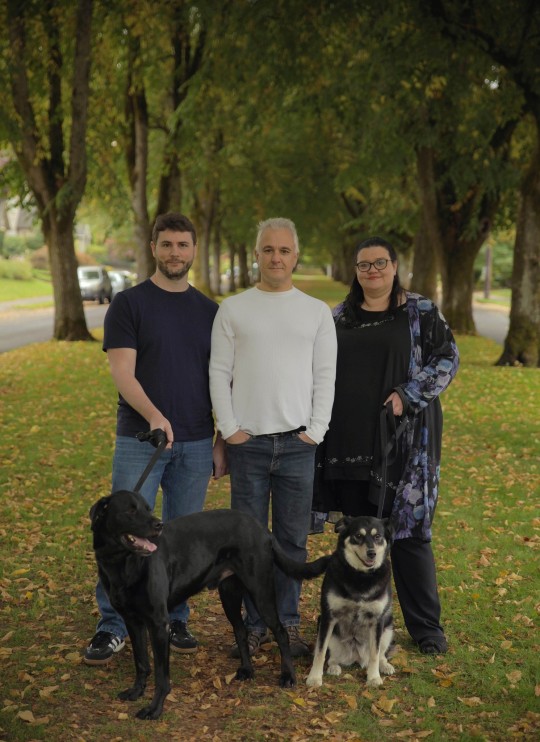
[ Perpetrators of an elaborate hoax against academic journals (from left) mathematics Ph.D. James Lindsay, UK academic Helen Pluckrose and philosophy professor Peter Boghossian. (courtesy) ]
“This is the primary point of the project: What we just described is not knowledge production; it’s sophistry. That is, it’s a forgery of knowledge that should not be mistaken for the real thing. The biggest difference between us and the scholarship we are studying by emulation is that we know we made things up,” they wrote.
In undertaking the hoax, the use of satire was often employed. According to the authors, every paper “also endeavored to be humorous in at least some small way (and often, big ones).”
The team was so successful that four journals asked the papers’ fictitious authors to become peer reviewers themselves. For “ethical reasons,” they declined.
The proverbial wheels came off after a Twitter account called “New Real Peer Review” sniffed something foul from the Dog Park essay. Soon, local newspapers became suspicious, and eventually, in cooperation with the hoax team, the Wall Street Journal broke the story this week, with an ever-widening international ripple effect and coverage.
Satire as social commentary
It is not the first time scholars have written hoax papers to illustrate a broken academia. While other fields can be equally guilty of publishing unscientific work, gender studies in particular has already been repeatedly flagged as problematic.
After the current hoax experiment became public this week, author and Harvard lecturer Yascha Mounk proclaimed on Twitter that “Three intrepid academics just perpetrated a giant version of the Sokal Hoax… Call it Sokal Squared. The result is hilarious and delightful. It also showcases a serious problem with big parts of academia.”
In 1996, mathematics and physics Prof. Alan David Sokal submitted a nonsensical paper to Duke University’s Social Text journal called “Transgressing the Boundaries: Toward a Transformative Hermeneutics of Quantum Gravity,” in a (successful) experiment illustrating editorial bias and the prevalent incorrect use of scientific terms.
The Sokal hoax was the basis for a May 2017 experiment when two of the current project’s authors, Boghossian and Lindsay, attempted to replicate his success with the publication of a fake paper that claims “that penises conceptually cause climate change.” They write about the experiment in an essay, “The Conceptual Penis as a Social Construct: A Sokal-Style Hoax on Gender Studies,” which discusses the problematic nature of “pay-to-publish” open access journals.
In September 2017 the duo became a trio with the addition of Pluckrose and the new, much more elaborate project was launched.
According to the scholars, the goal of the current project was not to end the study of these niche academic disciplines, rather highlight the intolerant thinking within their lock-step that is infiltrating popular culture.
Asked by The Times of Israel if academic journals in the field of Jewish Studies would also be in their sights, Lindsay answered that the team didn’t fully examine this particular field. “The grievance studies methods are dubious, and I hope [Jewish Studies scholars] don’t take them up,” he said.
“I’ve only looked closely at one paper in Jewish Studies and it seemed to use similar methods but criticized a nasty streak of antisemitism in critical race scholarship,” he wrote via Twitter, citing a paper called, “Critical Whiteness Studies and the ‘Jewish Problem.'”
The cited paper was written in response to the increasingly trendy theory proposed by Critical Whiteness Studies and promoted by young American Jews on college campuses, social media, and even mainstream Jewish media, that Jews are not “white.”
According to the paper’s abstract, “‘whiteness” is used as a critical concept denoting those who enjoy white privilege in American and other Western societies.” Calling a Jew “white,” however, “is more than controversial, for it assimilates the most persecuted minority in European history to the dominant majority, while downgrading the significance of antisemitism.”
The fact that this type of topic itself is being debated within the ivory tower and infiltrating popular culture is not what appears to bother the scholars. Rather, it is the fact that there are few skeptical and critical checks within peer-reviewed journals and that what they consider to be a “kind of blatant corruption” through confirmation bias is pervasive in the fields.
“Politically biased research that rests on highly questionable premises gets legitimized as though it is verifiable knowledge. It then goes on to permeate our culture because professors, activists, and others cite and teach this ever-growing body of ideologically skewed and fallacious scholarship,” writes the team.
“We managed to get seven shoddy, absurd, unethical and politically biased papers into respectable journals in the fields of grievance studies. Does this show that academia is corrupt? Absolutely not. Does it show that all scholars and reviewers in humanities fields which study gender, race, sexuality and weight are corrupt? No,” they write.
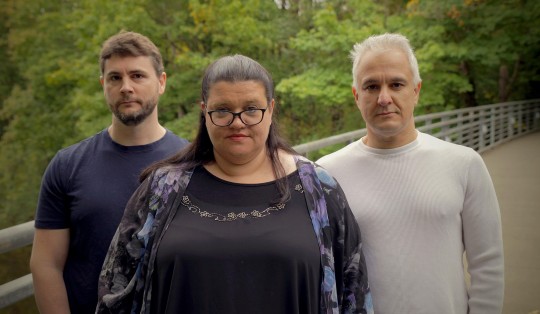
[ Perpetrators of an elaborate hoax against academic journals (from left) mathematics Ph.D. James Lindsay, UK academic Helen Pluckrose and philosophy professor Peter Boghossian. (courtesy) ]
However, when a journal publishes — without revisions — a paper written in under six hours by a man which describes “moon meetings” for women in womb rooms with vulva shrines, it might reasonably be thought that something is deeply amiss. When an essay which promotes the pedagogical boon of silencing and chaining “privileged” pupils to the floor to affect “experiential reparations” is taken under serious consideration and given notes for improvement, one might wonder about the Ivory Tower’s foundations.
The authors are now calling upon universities to conduct a thorough review of the grievance study fields “to separate knowledge-producing disciplines and scholars from those generating constructivist sophistry.”
“Research into these areas is crucial, and it must be rigorously conducted and minimize ideological influences,” they write. “The further results on these topics diverge from reality, the greater chance they will hurt those their scholarship is intended to help.”
--


==
Flashback to the days when this was shocking and hard to believe, rather than ordinary and everyday.
#Grievance Studies#sophistry#Peter Boghossian#Helen Pluckrose#James Lindsay#academic corruption#corruption of education#academic fraud#defund gender studies#woke#wokeness#cult of woke#wokeism#wokeness as religion
15 notes
·
View notes
Text
Some scholars have written dedicated research on the topic of religious and recreational usage of psychotropic plants in the ancient Greek and Roman World.
Carl Ruck, Albert Hoffmann, and Robert Wasson wrote The Road to Eleusis (1978), which sets the stage for exploring the use of entheogens in Greek and Roman culture. Ruck has additional publications, which focus on recreational and religious intoxication.
D. C. A. Hillman wrote The Chemical Muse (2008), where he covers drug usage in the ancient Greek and Roman world, including recreational, religious, and medical.
Michael Rinella wrote Pharmakon: Plato, Drug Culture, and Identity in Ancient Athens (2011), in which he delves into psychotropic plant usage in the ancient Greek world, the problematization of drugs, and the scandals surrounding Socrates and Alcibiades.
Alan Sumler wrote Cannabis in the Ancient Greek and Roman World (2018), in which recreational intoxication and other settings are explored.
[...]
In the field of ancient Greek and Roman religion and magic, some scholars have covered psychotropic plant usage. John Scarborough’s “The Pharmacology of Sacred Plants, Herbs, and Roots” (1991) covered these plants as used in ancient magic and explained the ancient rationale behind how they worked. He has also covered these plants in ancient medicine.
Christopher Faraone, in Ancient Greek Love Magic (2001), wrote about these plants as they are used in love magic and how they appear in other settings, like law courts.
Georg Luck’s Arcana Mundi (2006) covers these plants as they are found in religion and the personal practice of magic.
Alan Sumler, in “Ingesting Magic” (2017), considers these plants in magic and recreation.
On psychoactive plants found in ancient wine, Patrick McGovern, author of Uncorking the Past (2009), has written the most. His molecular analysis of ancient wine shows that the drink had multiple ingredients, many of them psychotropic. He describes the usage of intoxicating drinks all around Europe, Asia Minor, Egypt, and the Black Sea. McGovern covers recreational usage of drugs in the Greek and Roman world.
In the field of ethnobotany, there is scholarship on psychotropic plants being used in different settings in the Greek and Roman world. The assumption is that these psychoactive plants grow all over the earth and that all cultures use them for mind alteration in some way.
A recent multiauthored volume from Routledge, A Companion to Ecstatic Experience in the Ancient World (2022), covers psychotropic drug usage in the Mediterranean world going back to the Bronze Age.
Philip Wexler edited a two-volume multiauthored, text (2014, 2015), The History of Toxicology and Environmental Health, which covers many instances of recreational intoxication in the Greek and Roman world.
Some articles in scholarly journals are helpful for becoming familiar with psychotropic plant usage in the ancient world. Merlin, “Archaeological Evidence for the Tradition of Psychoactive Plant Use in the Old World” (2003), covers psychotropic plant usage throughout all ancient cultures. Carod-Artal, “Psychoactive Plants in Ancient Greece” (2013), considers substances available in the ancient Greek world. A few articles focus on Classical Greece, for instance Arata, “Nepenthe and Cannabis in Ancient Greece” (2004), and Eleanor, “Flower Power in Medicine and Magic: Theophrastus’ Response to the Rootcutters” (2006). The topic of kykeon at the Eleusinian Mysteries has produced some interesting scholarship, for instance Perrine, “Mixing the Kykeon” (2000), and Rosen “Hipponax fr. 48 Dg. And the Eleusinian Kykeon” (1987).
-- Alan Sumler, Intoxication in the Ancient Greek and Roman World
8 notes
·
View notes
Text
While the editors claim the historiography of Zionism, in reality theirs is a historiography for Zionism, a Zionist historiography seeking desperate renewal. In seeming response to Raz-Krakotzkin, the editors write in their introduction that in addition to Europe, Palestine and “in many other non-European spaces Zionist movements developed as well” (13). “Moreover,” they go on, “Zionists claimed a land outside of Europe not as a colony, but as their ancestral homeland” (13). While the latter part of that sentence is certainly true, and a core part of Zionist ideology, to argue that Zionists did not claim Palestine as a colony is a lie and nothing less. As is undoubtedly well-known to the editors, Zionists regularly and repeatedly referred to their efforts as a colonial project as countless historical studies have demonstrated, most recently Areej Sabbagh-Khoury’s meticulously researched and powerfully argued Colonizing Palestine: The Zionist Left and the Making of the Palestinian Nakba (2023). Moreover, the claim of Palestine as a homeland marked Zionism as more than simply another nationalism. In her review of The Holocaust and the Nakba: A New Grammar of Trauma and History (2018), Nadia Abu El-Haj carefully critiques the effort therein to define “the colonial” as “excess” and frame histories of Palestine and Israel in terms of competing nationalisms, without attention to the structure of settler-nationhood. “The distinction of Zionism,” Abu El-Haj makes clear, “is that it was a settler-nation from the very start: that is, it was a colonial project of settlement that imagined itself as a project of national return. Not only was there never any ideological space between the national and the settler-colonial. In contrast to settler-nations elsewhere (the US or Australia, for example), there was never any temporal distance either.”[6]
Every chapter in Unacknowledged Kinships seeks to eclipse the settler-colonial history of Zionism. A chapter by the historian Orit Bashkin, who has otherwise contributed to modern Arab intellectual history and the social history of Iraq and Israel in a series of well researched books, provides an overview of the recent scholarship on Arab Jewry. The chapter’s value, however, is diminished by an incoherent conclusion. “Finally, Zionism,” Bashkin writes, “was not simply a foreign movement imported from Europe and Palestine, as the postcolonial school would have it, or a natural response to Arab Fascism, as the conservatives have argued. Rather it was a local option, one among many, that appealed to Jews, especially as Arab national elites let them down and the conflict in Palestine seemed to have determined the lot of Jews outside it” (208). The conscription of some Arab Jews into Zionism does not make it local. Does the presence of American nationalism among some Indigenous or Black people make the United States any less a settler-colonial or slave society? Zionism was not “imported” from Palestine to elsewhere across the Arab world. The transplantation of a racial ideology that pitted “Arab” against “Jew” was a European Zionist project. All the major leaders of the Zionist movement in Palestine were European. Of the thirty-seven signatories of the Israeli Declaration of Independence, “all but two… were from Central or Eastern Europe,” as Ussama Makdisi reminds us.[7] To name Zionism “local” is to elide again, as this volume seeks to do, its colonial function.
...Quayson however, reveals himself a fellow traveler in the editors’ campaign, readily adopting their prejudice and the logic of the Israeli security state. In his Afterword to the volume, Quayson writes that the events at the 1972 Olympics in Munich were “stomach churning” as he observed them as a child in Ghana and that unlike “the foreign policy positions being taken by African states” the Israeli raid on Entebbe Airport in 1977 “served to consolidate the Israelis as heroes in our young eyes even further” (298). Quayson is certainly welcome to recount his youthful impressions (although readers may wish to consult proper histories of African and Third World solidarity with Palestinians in the same period to read alongside such anecdotes). But Quayson’s reliability is thrown into serious doubt when he turns to the 1982 massacres of Palestinians in the Beirut refugee camps of Sabra and Shatila. He characterizes them simply as a “public relations disaster” which “created a bitter taste toward Israel for many people in the postcolonial world” (299)—although apparently not for Quayson. While Israel’s complicity in the massacres is well-documented and well-known, Quayson seeks to absolve Israel by both raising doubts about these facts and justifying Israel’s actions due to the “complex geopolitical calculus” that Israel and its adjuncts in Lebanon were apparently working under, namely the perennial specter of Iran. Why? In the end Quayson makes clear his opposition to BDS, “something I personally think precipitously abandons the possibility of dialogue and collaboration with progressive Israel-based scholars” (299).
...Faisal Devji, in a piece that rehashes the arguments of some of his recent books on Pakistan and Gandhi, takes the opportunity to scold supporters of BDS with insidious comparisons. Arguing that “BDS has taken on the role that states and the international community are meant to play by imposing punitive sanctions on a criminal regime. This effort is inadvertently mitigated by the movement’s weakness and so its own vulnerability to sanctions of many kinds. Such vulnerability gives BDS its moral idealism, but this is promptly squandered by the desire to speak in the name or at least in place of the state and international order.”[12] Inexplicably, a stateless people, many of whom without even a passport to their name, endlessly abused by a state-system which restricts their movement and blocks their access to those legal mechanisms of international governance, are condemned for attempting even the smallest pragmatic use of that system. Shall we also condemn Six Nations of the Irouquis’s appeal for sovereignty to the League of Nations or the Civil Rights’ Congress historic charge of genocide against the United States presented to the United Nations in 1951?
Palestinians and their supporters, Devji goes on to argue, would do well to heed the example of the Gandhian refusals which mobilized millions against the British in India. No mention is made, of course, that Palestinians have been practicing civil disobedience in their land since before the State of Israel even existed. Or that the General Strike in Palestine in 1936 was the longest in human history (perhaps only surpassed by the hartal that consumed Kashmir in 2020). While Palestinians are daily arrested, maimed, and murdered for stepping out into the street or opening their lips, when dozens of Palestinians participate in wave after wave of hunger strike as they’re stuffed into cages, Devji, our Thomas Friedman, dares to ask where is the Palestinian Gandhi?
8 notes
·
View notes
Photo

A History of Ottoman Libraries
A History of Ottoman Libraries is a timely research that acknowledges the gap in Anglophone scholarship on Ottoman intellectual history. Part of the Ottoman and Turkish Studies series from Academic Studies Press, this book is aimed at scholars and students. It complements not only Orlin Sabev's book Waiting for Müteferrika (2018) in the same series but also the recent work, Empire of Salons (2022), by Helen Pfeifer. With that being said, İsmail E. Erünsal's work has something to offer to all book lovers and historians alike with its comprehensive detailing of the institution of the Ottoman library.
Continue reading...
92 notes
·
View notes
Text

Evelyn Berezin in 1976 at the Long Island office of her company Redactron. She developed one of the earliest word processors and helped usher in a technological revolution. Evelyn Berezin said her word processor would help secretaries become more efficient at their jobs. Photo By Barton Silverman/New York Times.
Evelyn Berezin, “Godmother of the Word Processor!” The Woman That Made Bill Gates and Steve Jobs Possible
Evelyn Berezin (1925-2018) was born in the Bronx to poor Russian-Jewish immigrants. Growing up, she loved reading science fiction and wished to study physics. She excelled at school and graduated two years early. Berezin had to wear make-up and fake her age to get a job at a research lab. She ended up studying economics because it was a more “fitting” subject for women at the time. During World War II, she finally received a scholarship to study physics at New York University. Berezin studied at night, while working full time at the International Printing Company during the day. She continued doing graduate work at New York University, with a fellowship from the US Atomic Energy Commission. In 1951, she joined the Electronic Computer Corporation, designing some of the world’s very first computers. At the time, computers were massive machines that could only do several specific functions.
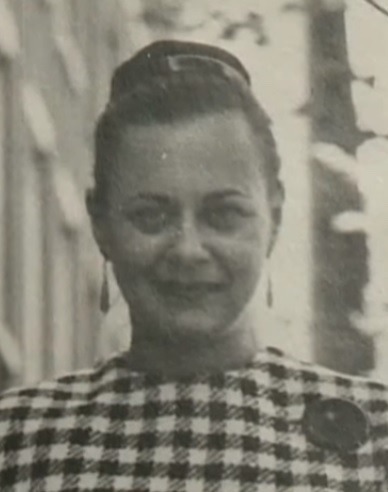
Evelyn Berezin, “Godmother of the Word Processor.” Born: April 12, 1925, The Bronx, New York City, NY — Died: December 8, 2018, ArchCare at Mary Manning Walsh Nursing Home & Rehabilitation Center, New York, NY
Berezin headed the Logic Design Department, and came up with a computer to manage the distribution of magazines, and to calculate firing distances for US Army artillery. In 1957, Berezin transferred to work at Teleregister, where she designed the first banking computer and the first computerized airline reservation system (linking computers in 60 cities, and never failing once in the 11 years that it ran). Her most famous feat was in 1968 when she created the world’s first personal word processor to ease the plight of secretaries (then making up 6% of the workforce).
“Without Ms. Berezin There Would Be No Bill Gates, No Steve Jobs, No Internet, No Word Processors, No Spreadsheets; Nothing That Remotely Connects Business With The 21st Century.” — The Times of Israel (12 December 2018)
The following year, she founded her own company, Redactron Corporation, and built a mini-fridge-sized word processor, the “Data Secretary”, with a keyboard and printer, cassette tapes for memory storage, and no screen. With the ability to go back and edit text, cut and paste, and print multiple copies at once, Berezin’s computer freed the world “from the shackles of the typewriter”. The machine was an in instant hit, selling thousands of units around the world. Berezin’s word processor not only set the stage for future word processing software, like Microsoft Word, but for compact personal computers in general. It is credited with being the world’s first office computer. Not surprisingly, it has been said that without Evelyn Berezin “there would have been no Bill Gates, and no Steve Jobs”.
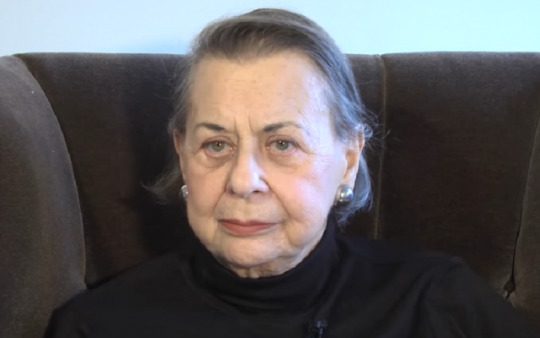
Evelyn Berezin Pioneered Word Processors and Butted Heads With Men! A ‘loud woman,’ she studied physics and found that to get to the top she had to start her own company. Evelyn Berezin later became a mentor to entrepreneurs, venture capitalist and director of companies. Photo: Berezin Family. Wall Street Journal
“Why Is This Woman Not Famous?” British Writer Gwyn Headley Wrote In A 2010 Blog Post. — The Times of Israel
Redactron grew to a public company with over 500 employees. As president, she was the only woman heading a corporation in the US at the time, and was described as the “Most Senior Businesswoman in the United States”. Redactron was eventually bought out by Burroughs Corporation, where Berezin worked for several more years. In 1980, she moved on to head a venture capital group investing in new technologies. Berezin served on the boards of a number of organizations, including Stony Brook University and the Brookhaven National Laboratory, and was a sought-after consultant for the world’s biggest tech companies.
She was a key part of the American Women’s Economic Development Corporation for 25 years, training thousands of women in how to start businesses of their own, with a success rate of over 60%. In honour of her parents, she established the Sam and Rose Berezin Endowed Scholarship, paying tuition in full for an undergraduate science student each year. Sadly, Berezin passed away earlier this month. She left her estate to fund a new professorship or research centre at Stony Brook University. Berezin won multiple awards and honourary degrees, and was inducted into the Women in Technology International Hall of Fame.
#Evelyn Berezin#Business & Finance#Science & Technology#Steve Jobs#Bill Gates#Computers#Computer Science#Microsoft Word#New York University#Physics#Teleregister#Word Processor#WWII#Redactron#Belarusian 🇧🇾 Russian 🇷🇺 Jewish
6 notes
·
View notes
Text

In tribute to the memory of the birthday for Mark "The Shark" Shelton!
Real/full name: Mark Wayne Shelton
Born on Dec 3rd, 1957.
R.I.P.: Jul 27th, 2018
Died of: Heart attack
Place of origin: United States (Wichita, Kansas)
Founder of Manilla Road and Roadster Records.
In the early 90s, Mark started a side-project named Circus Maximus, who played keyboard-heavy hard rock. They recorded one album, but the label intervened and insisted it was released under the Manilla Road moniker, and with The Circus Maximus as its title.
The Shark Project played folksy acoustic songs and perform locally in Wichita, Kansas.
Copyright Disclaimer under section 107 of the Copyright Act of 1976, allowance is made for “fair use” for purposes such as criticism, comment, news reporting, teaching, scholarship, education and research. Fair use is a use permitted by copyright statute that might otherwise be infringing.
#metalcultbrigade#metal#artists on tumblr#art#heavy metal#thrash metal#thrash#power metal#speed metal#manilla road
2 notes
·
View notes
Note
If you feel like it, I’d love to hear about your dissertation on Studio Ghibli. I’m so curious how you approached it. What did you focus on? Was there a lot of academic writing to situate your work or were you pretty much on your own?
sure, thank you so much for asking! this got a bit long so putting it under a read more
my degree was in english literature but the course had a strong film element, so i was looking at it from a literary/film studies perspective. the topic was on the way miyazaki's oeuvre rejects gender essentialist associations between gender and the "nature/culture dualism", i.e. the perceived dichotomy between the natural and human worlds. i arrived at that topic because a lot of the existing scholarship on miyazaki's work looks at it through a feminist lens or an environmentalist lens, and i wanted to try to combine the two. i focused on nausicaä of the valley of the wind and princess mononoke because they're big lynchpins of his filmography and they're very similar - mononoke is arguably a retread of the same narrative and thematic building blocks as nausicaä with miyazaki having 14 added years of experience.
to address the topic i ended up looking into ecofeminist theory and literary criticism as the theoretical background and reading a lot of donna haraway, who's a hugely influential figure in the scholarship on cultural dualisms (and whose work is also notoriously difficult to parse lmao). i also looked a bit at what had been written on women in anime and manga, which involved some reading about shoujo, and generally looked into the english language scholarship on anime. i also wanted to learn more about miyazaki as a person and a filmmaker and my main references for that were the documentary 10 years with hayao miyazaki and the books starting point and turning point, which compile interviews he's given and things he's written about his own work from 1979 to 2008.
with regards to scholarship on miyazaki's work, i was limited to english language scholarship as i can't read japanese. there is certainly some english scholarship on him - he's by far the most written about japanese anime director in english scholarship - but there's not nearly as much as you might expect for such an accomplished and influential filmmaker, especially when you start narrowing it down to the scholarship on individual films. i'd say this is due to a historical lack of respect for anime in general from academics (even my supervisor was quite skeptical of it throughout the project lol). a lot of my most important references were quite recently published - the book princess mononoke: understanding studio ghibli's monster princess is the first collection of essays on princess mononoke to be published in english and it only came out in 2018 (i did the dissertation in 2021). a really prominent figure in my bibliography was susan napier, who was one of the first western scholars to give anime a legitimate place at the table back in the late 90s, and who published miyazakiworld: a life in art in 2018, which i think is a really accessible academic perspective on his work. (she also did this ted talk about being looked down upon for taking anime seriously which is an interesting watch if you have 15 minutes)
a lot of the journal articles i referenced can be found on this site, which is compiled by someone who's not a film or literary scholar but is just a genuine enthusiast for anime and manga studies (they also have a degree in library and information science - my current area of study! - so no wonder the site is well organised and well researched lol). their bibliography for articles about miyazaki's work can be found here - obvs you'd need institutional access to read most of that and i can't guarantee this list is exhaustive especially since it's been 3 years since i was researching this but i think it gives a good idea of how much is out there. again it's far from nothing but it's also not a huge amount, which to be honest i think made my project a lot easier and more manageable than a dissertation on someone who's received a lot of scholarly attention would've been. i could get a really good grasp of the entire scholarly field, which would've been impossible if i'd been writing on, say, jane austen.
it was a really fun topic to write about for my dissertation! i bought copies of the books i've linked because i loved the research process so much (another book i bought and recommend is the anime art of hayao miyazaki, which focuses on the more technical aspects of his filmmaking). i do think i was limited by my inability to read japanese and i'd love to find out what's going on in the japanese scholarship but i'm still pretty happy with what i was able to do. again thanks for asking about it and giving me an excuse to talk about it lol
11 notes
·
View notes
Text
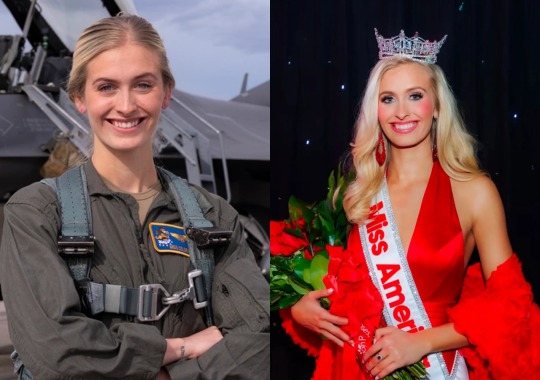
U.S. Air Force officer and F-16 pilot is crowned Miss America in 2024
Fernando Valduga By Fernando Valduga 01/16/2024 - 08:27 in Military
Madison Marsh of Colorado defeated 50 other Miss America competitors representing the 50 states and the District of Columbia on Sunday, thus taking the crown. The 22-year-old, second-teent of the U.S. Air Force, is the first active military to win the competition.
Before his decisive victory, Marsh, a native of Arkansas, said that the pomp "really relates a lot to the military because you are serving, but in a different way".

“When I wear my uniform, I serve and represent our country,” Marsh said. "When I put on the crown and the band, I'm serving, representing my community."
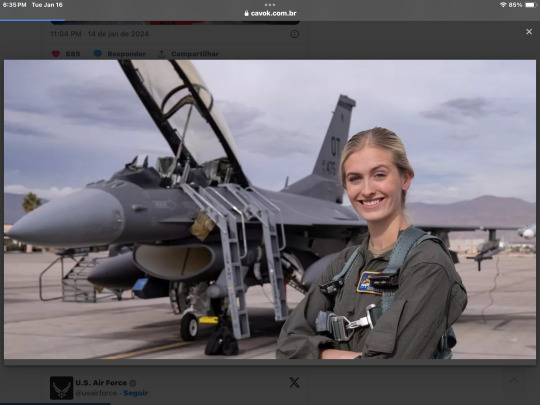
The USAF quickly congratulated her, noting that "Marsh is currently pursuing her master's degree in public policy at Harvard Kennedy School through the Civil Institution Program of the Air Force Institute of Technology, which falls under Air University".

The Air Force added the hashtag "AimHigh".
Marsh is attending Harvard Kennedy School with a Harry S. scholarship. Truman. She credits the Air Force Academy, where she graduated in physics, with the help to turn her into a leading candidate.


“I don't think I would have entered Harvard if I hadn't gone to the Air Force Academy,” Marsh told Crimson. "I think I would never have become Miss Colorado without the Air Force Academy, because they trained me and improved my leadership."
Earlier this month, the Air Force Academy shared photos of Marsh, who obtained his pilot license at the age of 16, next to a glider, with the caption: "From the flight line to the spotlight". During the talent part of the finals of the competition on Sunday, Marsh recalled the joy and suspense of his first solo flight.

Before studying at Harvard Kennedy School, Marsh worked as an intern at Harvard Medical School, looking for ways to use artificial intelligence to detect pancreatic cancer, and as an intern at NASA, researching gamma-ray explosions, according to Miss Colorado.
In addition to his studies, Marsh is also a black belt in taekwondo.
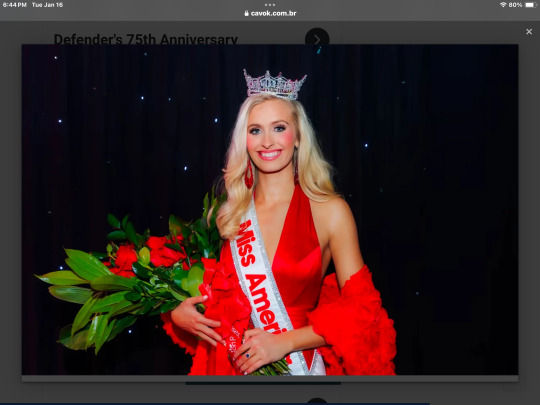
After his victory, Marsh wrote in an Instagram post: "My mother - this is all for you".
Marsh founded the Whitney Marsh Foundation after his mother succumbed to pancreatic cancer in 2018. As president of the foundation, she raised more than $250,000 for cancer research.
Marsh, previously crowned Miss Colorado in 2023, indicated that she intends to apply her knowledge to cancer research and apply it to her political diploma, “trying to translate them to ensure that we are enacting policies that are equitable for all patients.”
youtube
The crown comes with a $60,000 scholarship and an opportunity to travel through the U.S. as a Miss America ambassador.
The mayor of Colorado Springs, Yemi Mobolade, noted in the X: "Madison, @CityofCOS wishes you great success. You inspired countless girls to dream big and reach the stars. Congratulations!"
Tags: Military AviationF-16 Fighting FalconUSAF - United States Air Force / U.S. Air Force
Sharing
tweet
Fernando Valduga
Fernando Valduga
Aviation photographer and pilot since 1992, he has participated in several events and air operations, such as Cruzex, AirVenture, Dayton Airshow and FIDAE. He has works published in specialized aviation magazines in Brazil and abroad. He uses Canon equipment during his photographic work in the world of aviation.
Related news
MILITARY
The image of the Russian Ilyushin Il-22M hit by the Ukrainian air defense appears
15/01/2024 - 23:19
MILITARY
Royal Jordanian Air Force signs contract for new F-16C/D Block 70 fighters
15/01/2024 - 20:35
MILITARY
Royal Dutch Air Force deploys MQ-9A Reaper drones in Romania
15/01/2024 - 17:00
MILITARY
Uruguayan Air Force acquires Tecnam P2012 aircraft
15/01/2024 - 16:00
MILITARY
French Mirage 2000 jets can strengthen the Ukrainian Air Force, says commander
15/01/2024 - 12:30
The first of two AH-64E Apache helicopters of the Royal Dutch Air Force (RNAF) is loaded on a C-17 aircraft for transport to Woensdrecht Air Base in the Netherlands.
HELICOPTERS
The Netherlands receives two more Apache Guardian attack helicopters version 6
15/01/2024 - 11:00
7 notes
·
View notes
Text
by Dion J Pierre
The City University of New York (CUNY), a higher-education consortium with 25 campuses across the five boroughs, has hired prominent academic and anti-Israel commentator Marc Lamont Hill as the CUNY Graduate Center’s “presidential professor” of urban education, a university spokesperson confirmed to The Algemeiner.
Hill’s hiring this week has already stirred controversy in light of both his past comments concerning Israel and Zionism and numerous civil rights complaints alleging that CUNY itself fosters a hostile, antisemitic environment in which members of the Jewish community are threatened and harassed.
In 2018, Hill was rebuked by Temple University, his former employer, and fired by CNN after calling for a “free Palestine from the river to the sea,” a slogan widely interpreted as a call for the destruction of Israel.
Recently, Hill posted a photograph of himself holding a sign that said he supported the American Anthropological Association’s endorsement of the the so-called Boycott, Divestment, and Sanctions (BDS) movement, which seeks to isolate Israel from the international community as a step toward the Jewish state’s eventual elimination. Hill has also publicly associated with Nation of Islam leader Louis Farrakhan in the past and refused for many months to denounce his antisemitism.
During a 2018 interview with The Breakfast Club, a popular urban radio broadcast, Hill called Farrakhan his “brother” and accused Israeli police of training American officers to kill Black people.
“What is happening is a normalization and legitimization of Jew-hatred that has really become part and parcel of the academy,” Tammi Rossman-Benjamin, who founded the AMCHA Initiative nonprofit to research and track antisemitism in American higher education, said of CUNY’s decision to hire Hill in an interview. “And it’s not just that he’s proud of that and proud to tell you that, it’s that this is how he sees himself as an academic. His obsession with the Jewish state is actually the centerpiece of his scholarship, and that is probably why he was hired at CUNY.”
Rossman-Benjamin added that CUNY administrators and faculty have signaled their commitment to anti-Zionism before — including in 2022, when the CUNY Law School faculty endorsed a BDS resolution. She explained that faculty there and throughout the university system place political activism above scholarship, citing as an example the law school’s description of itself as a training ground for “radical lawyering,” a term drawn from far-left literature.
“Hill is a staunch advocate of the BDS movement,” Asaf Romirowsky, executive director of the Association for the Study of the Middle East and Africa, told The Algemeiner. “He ignores the total makeup of Israeli society, buying hook, line, and sinker into the white colonial narrative even though Israel largely comprises Jews of color. He’s a total propagandist in that regard, and he has made those accusations about Israel often to his own detriment. And I think people should be appalled that CUNY is legitimizing him.”
Romirowsky argued that Hill’s hiring is inconsistent with CUNY’s alleged efforts to address antisemitism on campus, a cause that CUNY Chancellor Felix Matos Rodriguez appeared to embrace in several public messages.
“Clearly Rodriguez’s comments have no teeth,” he continued. “Actions have to follow stating one’s commitment to fighting antisemitism. Bringing a known antisemite who has been so vocal and so pronounced about his views sends a contradictory message. I think the faculty fighting antisemitism at CUNY should be deeply concerned about what’s happening there.”
CUNY on Wednesday defended its hiring of Hill as a decision driven by merit, adding that several Jews served on the hiring committee that selected him.
“Professor Hill, a widely respected expert in his field, was unanimously selected by the Urban Education hiring committee for a position that focuses on advancing conversation and research about the role of education in American society,” a spokesperson for the university told The Algemeiner. “The committee reviewed the entirety of his scholarship and public comments, which include a public letter of apology for remarks made half a decade ago and his strong, unequivocal condemnations of antisemitism and antisemitic violence.”
The City University of New York is currently under investigation by the US Department of Education’s Office for Civil Rights (OCR) for allegedly neglecting to discipline a student, Nerdeen Kiswani, who threatened to set her classmate on fire for wearing an Israel Defense Forces (IDF) hoodie, and for failing to protect another Jewish student from harassment. CUNY is also the subject of a Title VI complaint, which was filed in July 2022 by the American Center for Law and Justice after accusations of antisemitism at CUNY campuses were aired during a New York City Council hearing held the previous month. It alleges that CUNY has intentionally ignored “a sustained pattern of antisemitism.”
Another investigation, launched in February 2022, is reviewing complaints that Jewish students enrolled in CUNY Brooklyn College’s Mental Health Counseling master’s program were browbeaten into denying their heritage and identifying as white. One student allegedly begrudged one of her Jewish classmates so much that she admitted in a WhatsApp group chat to fantasizing about strangling her, an anonymous student told The Algemeiner at the time.
In May, CUNY again came under a shroud of criticism when student Fatima Mohammed alleged that Jewish money influences the university’s Israel policy during a CUNY Law School commencement ceremony. Despite being widely condemned by Jewish groups and local and national lawmakers —including New York City Mayor Eric Adams (D) — 40 CUNY Law faculty issued a statement supporting Mohammed’s remarks, describing them as “heartland First Amendment speech.”
In Sept. 2022, CUNY Chancellor Felix Matos Rodriguez acknowledged that “more needs to be done” to fight antisemitism at the university’s 25 campuses.
Neither Rodriguez nor Hill responded to The Algemeiner’s requests for comment about the latter’s hiring.
10 notes
·
View notes
Text
Persephone Rowen Grey


"you are a force of nature, dear your breath curls from your lips"


"we could be hanging around here for centuries trying to make sense of this, my dear"
about Persephone:
suitors: Arthur & Faust
scorpio sun, scorpio moon, capricorn rising
Born in November 1995, Persephone was initially still born but was revived out of the womb, this is why her mother named her Persephone, like her older sister Artemesia named after a historical or mythological figure her mother admired. Her father left before she was born, leaving her to be raised by a single mother who wanted her daughters to have more opportunities than she had fostering a deep curiosity and thirst for knowledge in both of her daughters.
The trio were a close and loving family and they grew into intelligent and athletic girls who ended up winning them both scholarships to an elite girls public school where their mother worked as a secretary. Both Persephone and her sister ended up not only excelling academically, but finding passions outside of it with Artemisia becoming a skilled hockey player and Persephone discovering her love for ballet. She spent 2 years after finishing school in a French ballet company and touring Europe before going onto Edinburgh University to study a masters in Art History & English Lit.
Towards the end of her masters, Persephone began being mentored by a visiting respected expert in the Romantic movement; he was fresh out of a divorce, 25 years older and very attractive, who encouraged her to apply for a PhD at Cambridge where he was based so he could supervise her research. She was accepted but in the months before it began she, her mother and sister were involved in a car accident where she was the only survivor. When she began the PhD she was deep in mourning but couldn’t face dealing with it so she threw herself into her research and the mutual attraction between her and her supervisor ended up blossoming into a full fledged relationship. It was passionate, but also toxic, eventually leading to her having to abandon her path of being a researcher. After it all fell apart, she moved to London and began making money as an exotic dancer, eventually relocating to Berlin, then Paris where on one fateful day visiting the Louver she followed a certain gentleman through a very special door…
Personality:
Doesn’t suffer fools gladly, with a wit and winged eyeliner sharp enough to kill a man
Her favorite song is Lyre of Orpheus by Nick Cave and the Bad Seeds
Her favorite writer is Angela Carter
Her favorite film is Suspiria (2018)
Scorpio sun, Scorpio moon, Capricorn rising
Can out drink Arthur but not Faust or Comte
Fluent in French, conversational in German, Dutch and a good grasp of Latin
Her two passions are ballet and literature, she spent 2 years in Ballet of the Opéra National de Bordeaux touring Europe before going to Edinburgh University to study an MA in History of Art & English Lit
She only let those close to her call her Effy. The nickname was given to her by her sister who couldn’t pronounce her full name when they were younger, calling her Pers-effy instead of Per-sep-on-ne. Otherwise she prefers people use her full name, but will put up with being called Percy
She has a bit of an insecurity over how small her breasts are, it was made worse by her ex who would sometimes use it to mock her
Has a strong sibling-like bond to Theo & Vincent because they remind her of her older sister Artemisia. Including often engaging with arguments and prank wars with Theo while Vincent tries to mediate the chaos
When she was a girl, she had framed pictures of Arthur Conan Doyle and Percy Shelly decorated with love hearts and used to dream about marrying one of them. She will never tell Arthur this even under pain of death
Appearance:
5 ft 8” with a lithe, slightly androgynous but strong figure due to years of ballet training. Dark and wavy reddish brown hair prone to frizz, freckles both on her face and body with heterochromatic eyes - one blue, one gray but it’s not obvious without close observation. Her face is quite sharp in terms of structure but still keeps a softness with a slightly crooked nose due to a hockey accident and one eyebrow having a patch missing due to a mishap with a piercing in her teen years.
3 notes
·
View notes
Text

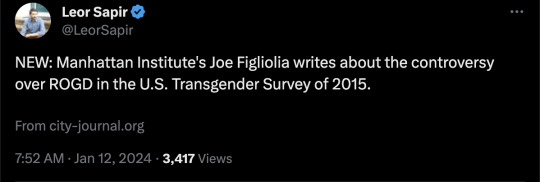
By: Joseph Figliolia
Published: Jan 11, 2024
When I learned of the controversy over Lisa Littman’s seminal paper from 2018, which introduced the concept of rapid onset gender dysphoria (ROGD), I did not understand the nature of the backlash. Littman’s paper appeared in a respected journal, Plos One, and had passed through the peer-review process. Shortly after its publication, however, the dean of public health at Brown University, where Littman, a physician, worked, published a letter noting that the Brown community was concerned that “conclusions of the study could be used to discredit the efforts to support transgender youth and invalidate perspectives of members of the transgender community.”
The letter also claimed that Littman’s research design and methods were problematic, despite her paper’s surviving an unusual post-publication assessment by senior journal editors, academic editors, a stats reviewer, and an expert reviewer. Littman claims that, after the post-publication review, her methods and findings were left virtually intact in a republished version of the paper. Most of the changes involved highlighting how her data were collected from parent reports and the limitations of those reports.
But the dean’s letter and the backlash to Littman’s paper suggest that critics’ real concern was Littman’s tentative conclusion suggesting the emergence of a novel developmental pathway to gender dysphoria. In her study, Littman hypothesized that a new form of gender dysphoria, and trans-identification, was presenting among peer groups of adolescent girls typically immersed in online trans subcultures and who often had preexisting mental-health and developmental issues. Strikingly, most of these girls had no childhood history of gender dysphoria, or even gender nonconformity, and their newly announced identities seemed unexpected and caught their parents by surprise.
Littman speculated that gender dysphoria was becoming a catch-all interpretive framework for a range of phenomena, from normal pubertal angst to specific mental-health issues. She also speculated that, among youth with existing mental-health issues or unprocessed sexual trauma, a trans identity could serve as a maladaptive coping mechanism to avoid dealing with intense negative emotions. This notion was tentatively supported by her finding that 61.4 percent of parents surveyed reported that their trans-identifying children were easily “overwhelmed by strong emotions and go to great lengths to avoid experiencing them.”
Critics realized that Littman’s hypothesis directly challenged the tenets of gender-identity theory, which hold that people have a felt sense of gender that is both innate and immutable. That theory has become a central justification for hormonal and surgical body modification. Critics alleged that Littman’s method of surveying parents was unreliable, but Littman showed that her method was consistent with other papers that support “gender affirmation” and are widely accepted by the pro-affirming side.
Fast forward six years, and Littman’s academic critics seem more committed to their intellectual and ideological priors than pursuing truth. Their main argument against ROGD is that what appears to parents as the sudden onset of transgender identity is really a late disclosure of an identity that has existed since childhood, even if the adolescent hasn’t felt comfortable revealing it to family and friends.
In a recent letter to the editor published in the Archives of Sexual Behavior, the Manhattan Institute’s Leor Sapir, along with Lisa Littman and Michael Biggs, take on the latest iteration of this argument in a paper by researcher-activist Jack Turban and his colleagues. The paper, “Age of Realization and Disclosure of Gender Identity Among Transgender Adults,” purports to show evidence of the early-realization/late-disclosure explanation for the rise in ROGD. Sapir et al.’s letter not only indicts Turban et al.’s subpar research but also, by extension, the current state of academic publishing on matters pertaining to identity (exemplified by the “ethics guidance” released by the journal Nature Human Behaviour).
Turban et al.’s argument is based on responses from the 2015 U.S. Transgender Survey, the largest of its kind to date, with a total of 27,715 respondents. USTS-15 asked adult participants to recall—and as critics have pointed out, recall itself is notoriously unreliable—at what age they “first felt their gender was different from their assigned birth sex” and at what age they “start to think they were trans (even if they did not know the word for it).” Turban and his coauthors took the answer to the first question rather than the second as the moment respondents first “realized they were transgender” and assessed the median time between realization and the disclosure of the identity to others. They divided participants into a “early realization” group (age ten or younger) and a “late realization” group (11 or older). Because a key premise of ROGD is that a trans identity develops rapidly within the context of adolescence, if the Turban study could show that a trans identity developed in childhood but was only disclosed later, it would undermine the ROGD hypothesis.
Yet, Turban and his colleagues seem uninterested in rigorously testing the ROGD hypothesis. Well-known for his mischaracterization of existing research, Turban made interpretive choices that strongly suggest he and his coauthors were avoiding any USTS-15 data that might undermine their broadside against ROGD.
Sapir et al.’s response is worth reading in full, but some examples of their findings should suffice here. First, to be eligible to participate in USTS-15, respondents had to identify currently as transgender. By definition, this means that anyone who identified as trans as adolescents but no longer did so as adults was excluded. Since this excluded group may include individuals whose dysphoria presentations match the ROGD phenomena, the USTS-15 sample is highly biased against ROGD hypothesis testing. Amazingly, Turban and another coauthor pointed out this limitation of the sample in a previous paper they published. Here, however, they simply ignore it.
Second, the ROGD phenomenon is hypothesized as an emergent phenomenon among a cohort of trans-identifying youth who came of age in the late 2000s or later—intersecting with widespread changes in social media, phone use, and the rise of the transgender social movement—which means that the phenomena would apply only to the 18–24 age group of the USTS-15. Despite this, Turban & colleagues analyzed the time period from realization to disclosure for the entire adult sample, and then only for those who said that they had early realization (age 10 or younger)—meaning not the cohort that would be relevant to ROGD.
Third, Turban and his coauthors chose as their proxy for age of realization a question put to participants about their age when they “felt that their gender was different than their birth sex”—instead of another question that asked them “at what age they first thought they were trans.” Asking people about their gender is more nebulous and less precise than asking them when they first thought they were trans. Not least, the problem of recall bias means that adult respondents—who, in this case, were recruited through transgender advocacy networks—could retroactively interpret reasons for “feeling different” through a gendered lens. In short, “feeling different” is a less reliable proxy for “realization” than an explicit question about the adoption of a transgender identity.
Turban et al. don’t explain this interpretive choice, but one suspects the reason: it produces a longer time from realization to disclosure. Because they take respondents’ answers about when they first “felt different” (which they code as “realized they are transgender”) at face value, they are left defending the absurd proposition that hundreds of USTS-15 respondents realized that they were transgender before their second birthday.
As Sapir’s letter notes, had the researchers analyzed data for the precise measure, they would have found that nearly 75 percent of the total sample reported late realization of a trans identity, compared with 40.8 percent originally reported. Moreover, data analyzed for the precise measure in the ROGD 18–24-year-old cohort reveals participants reported 83 percent late realization and only 17 percent early realization.
Of central importance, Turban and his coauthors claim to find that the median time from realization to disclosure was 11 years and the mode was 13 years. Had they analyzed the correct group (“late realization”), they would have found that both males and females had a mode of one year and a median of three years. In a follow-up reply to critics, Sapir and Littman point out that 2,127 respondents to the USTS-15 said that they went from “first feeling different” to disclosing a transgender identity to others in one year or less. The number of respondents who went from “first feeling they are transgender” to disclosing that identity to others within the same timeframe was 3,685. The denominator here (all 18–24-year-old respondents) was 5,880, which means that the data source Turban et al. themselves chose as reliable for testing ROGD shows that between one-third (if we’re being generous to Turban) and two-thirds (if we’re taking respondents’ report of “realizing they are transgender” at face value) meet the criteria for “rapid” development of transgender identity.
Additional features obscured in the Turban analysis also support the ROGD hypothesis. For example, ROGD is hypothesized to affect women more than men due to greater susceptibility to peer influence and because of the documented mental-health crisis among girls. While the Turban paper reports that 63.2 percent of the late-realization group was female, that percentage increases to 75.2 percent if only the relevant 18-24-year-old cohort is analyzed. Relatedly, data from the 18-24-year-old cohort also reveals that the younger cohort reported more psychological distress than older cohorts—lending more support to the ROGD hypothesis that trans-identification is a coping mechanism for preexisting psychological distress. This is consistent with research suggesting that comorbidities predate trans identification in this cohort.
Taken together, it is hard to see Turban et al.’s paper as anything but a sloppily engineered effort to discredit a hypothesis the authors disagree with for political reasons. That the Journal of Adolescent Health published their paper is yet more evidence of the ideological capture of medical journals. To add insult to injury, Sapir posted a thread on X regarding his letter to the editor and tagged the Journal of Adolescent Health, which promptly blocked him. This is behavior befitting a moody teenager, not the managers of a medical journal’s social media account.
==
Jack Turban is an activist, not a researcher, not a scientist. He just uses the language, but he doesn't even understand what "evidence-based medicine" means.
#Joseph Figliolia#ROGD#rapid onset gender dysphoria#Lisa Littman#gender ideology#queer theory#gender identity#medical corruption#ideological capture#medical fraud#trans identity#religion is a mental illness
6 notes
·
View notes
Text
Dragonar Fort.
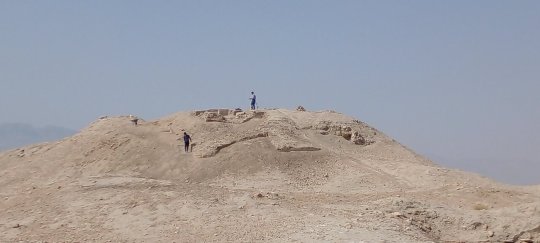
TEHRAN – A recently finished archaeological excavation,on the ruins of a massive fort is southern Iran,reveals the monument was initially used in Sassanid era and later during the early Islamic epoch up to the late Qajar era.
Covering some 20 ha in area, Qale Ezhdeha-Peykar, whose name literary translates into ‘dragon-bodied’ fort, is situated on a mound in Lar county of Fars province, southern Iran, Mehr reported on Tuesday.
The [archaeological] site consists of three ridges on the north, middle, and south, and was surrounded by a defensive wall in which watchtowers were built at regular intervals, the remains of which can be seen today.
The excavation indicates the history of settlement in this area stretches to the Sassanid era (224–651) and then it continued to be inhabited from early Islamic centuries until the end of the Qajar period (1789-1925).
Conducted under the supervision of the Research institute of Cultural Heritage and Tourism, the dig makes the first archaeological season on the fortress, the report said.
The Sassanid era (224 CE–651) is of very high importance in the history of Iran. Under Sassanids, Persian art and architecture experienced a general renaissance. Architecture often took grandiose proportions, such as palaces at Ctesiphon, Firuzabad, and Sarvestan, which are amongst the highlights of the ensemble.
Crafts such as metalwork and gem engraving grew highly sophisticated, yet scholarship was encouraged by the state. In those years, works from both the East and West were translated into Pahlavi, the language of the Sassanians.
The Sassanid archaeological landscape also represents a highly efficient system of land use and strategic utilization of natural topography in the creation of the earliest cultural centers of the Sassanid civilization.
The Muslim conquest of Persia, also known as the Arab conquest of Iran, led to the fall of the Sasanian Empire of Iran (Persia) in ca. 651 and the eventual decline of the Zoroastrian religion. The rise of Muslims coincided with an unprecedented political, social, economic, and military weakness in Persia.
In 2018, UNESCO added an ensemble of Sassanian historical cities in southern Iran — titled “Sassanid Archaeological Landscape of Fars Region”-- to its World Heritage list. The ensemble comprises eight archaeological sites situated in three geographical parts of Firuzabad, Bishapur, and Sarvestan. It reflects the optimized utilization of natural topography and bears witness to the influence of Achaemenid and Parthian cultural traditions and Roman art that later made a significant impact on the architecture and artistic styles of the Islamic era.
Source:https://www.tehrantimes.com/news/490340/Dragon-bodied-fort-in-southern-Iran-dates-from-Sassanid-era
#iran persia#Archaelogy#Excavation#Ancient Persia#Shiraz Iran#Iran Tehran#Dragon-bodied#tourism#ایران#イラン#龍の体を持つ#考古学的発掘#ユネスコ#古代ペルシャ#考古学
6 notes
·
View notes